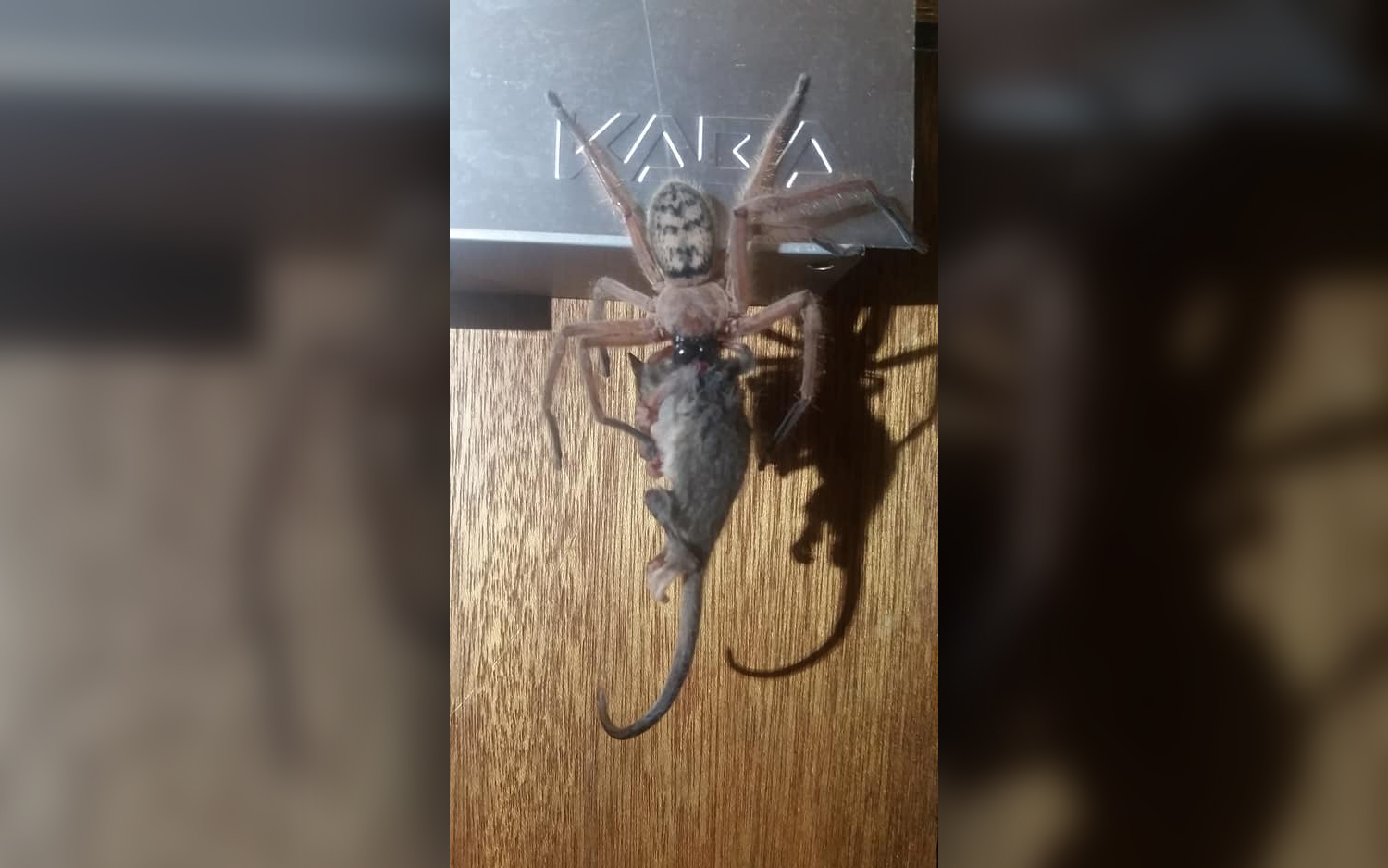Huntsman Spider Devours Possum in Viral (and Terrifying) Photos

In Australia — where else? — a large spider recently demonstrated the dominance of arachnids over puny mammals, as it chowed down on an unfortunate pygmy possum.
Southern Tasmania resident Justine Latton shared her husband's photos of the gruesome meal on June 14 in the Facebook group Tasmanian Insects and Spiders. He captured the images at a lodge in Tasmania's Mount Field National Park while doing light repair work, Latton said yesterday (June 18) on the radio program "Tasmania Talks."
Members of the Facebook group identified the arachnid as a huntsman (also known as a giant crab spider); these large, long-legged spiders in the Sparassidae family live all over Australia. In the photo, the huntsman hangs head-down from a door hinge and grips its prey by the neck. The dead marsupial — which appears to be a pygmy possum, according to commenters — dangles limply from the huntsman's mandibles. [In Photos: A Tarantula-Eat-Snake World]
The animal commonly known as a possum in North America (actually an "opossum," which belongs to a different order) can grow to be as big as a cat; were that the case here, the spider would easily be the size of a large dinner plate. But pygmy possums (Cercartetus lepidus) are the smallest possums in the world, measuring about 2 to 3 inches (5 to 7 centimeters) long and weighing about 0.2 ounces (7 grams), according to Tasmania's Parks and Wildlife Service.
On average, a huntsman spider's leg span can reach up to 6 inches (15 cm), while their bodies measure about 0.7 inches (2 cm) long, the Australian Museum reported.
Latton's husband was conducting repair work at the lodge when he noticed the spider lurking on the door just above his co-worker's head, Latton told "Tasmania Talks." The two captured the spider in an empty ice-cream container and released the huntsman outside the lodge; the arachnid skedaddled and left its possum meal behind, Latton said.
Huntsman spiders are ambush predators, and they use their large and powerful fangs to deliver venomous bites. Spiders are commonly thought to suck the liquids from their prey; in reality, they vomit digestive fluid onto their meals, chew the saturated flesh and then slurp up the dissolved nutrients, Rod Crawford, curatorial associate of arachnids at the Burke Museum in Seattle, wrote on the museum website.
Get the world’s most fascinating discoveries delivered straight to your inbox.
Huntsman spiders' usual prey includes many types of insects, reptiles and even other spiders. But it shouldn't come as a surprise that small mammals are also occasionally on the menu. Numerous spider species worldwide are known to eat bats, and researchers recently recorded the first evidence of tropical spiders preying on mouse opossums, in the Peruvian Amazon, Live Science previously reported.
- Goliath Birdeater: Images of a Colossal Spider
- In Photos: The Amazing Arachnids of the World
- In Photos: Tarantulas Strut Their Stuff
Originally published on Live Science.

Mindy Weisberger is a science journalist and author of "Rise of the Zombie Bugs: The Surprising Science of Parasitic Mind-Control" (Hopkins Press). She formerly edited for Scholastic and was a channel editor and senior writer for Live Science. She has reported on general science, covering climate change, paleontology, biology and space. Mindy studied film at Columbia University; prior to LS, she produced, wrote and directed media for the American Museum of Natural History in NYC. Her videos about dinosaurs, astrophysics, biodiversity and evolution appear in museums and science centers worldwide, earning awards such as the CINE Golden Eagle and the Communicator Award of Excellence. Her writing has also appeared in Scientific American, The Washington Post, How It Works Magazine and CNN.



